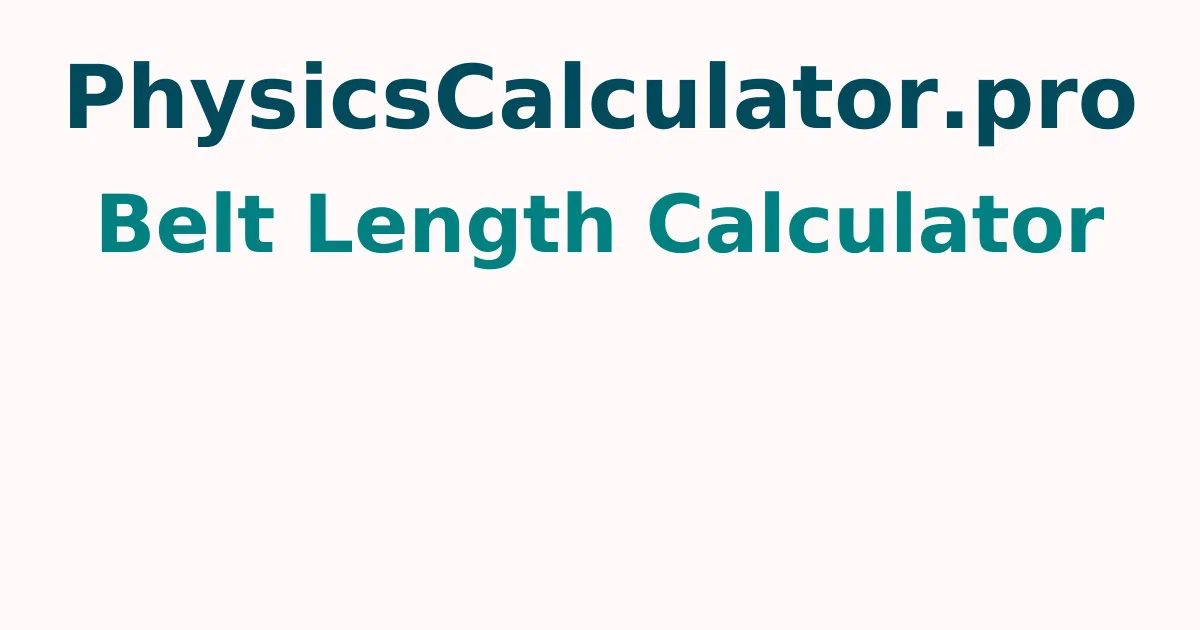Belt Length Calculator
Belt Length Calculator is a free online tool that calculates the length of any type of belt, including ribbed, flat, timing, and v-belts. To obtain the belt length quickly, simply enter the input parameters such as large pulley diameter, small pulley diameter, and centre distance, then press the calculate button.
Two Pulley System Belt Length
Pulleys have been around since before 200 B.C. They were originally used to carry buckets of water from wells, rivers, and other sources. They're now found in clock movements, building sites, and elevators, among other places. Only the tip of the iceberg has been shown. This type of system is utilised to transmit torque (or power) across axles, allowing for mechanical advancement.
Belt Length Formula
Learn how to calculate the belt length in a two-pulley system by using the formula listed below. Find the belt length by inserting the pulley diameters and the distance between the axles.
Belt Length = ((DL+DS)*π/2) +(DL-DS)*arcsin((DL-DS)/2L)+2*sqrt(L^2-0.25*(DL-DS)^2)
- Where, DL = the large pulley's diameter.
- DS s= the smaller pulley's diameter.
- L = the distance between the pulley axles.
Another Formula for Belt Length
If you don't have time to calculate the belt length precisely, you can use this alternate formula to quickly determine the belt length.
Belt Length = ((DL+DS)*π/2) +(2*L)+(DL-DS)^2/(4*L)
- Where, DL = diameter of the large pulley
- DS = diameter of the smaller pulley
- L = distance between pulley axles
When you need to make quick calculations, you can use this simple formula. However, if one pulley is larger than the other or if both are closer together, this calculation fails.
For more concepts check out physicscalculatorpro.com to get quick answers by using this free tool.
How to Calculate Belt Length?
To easily evaluate the belt length, simply follow the instructions given below. They are arranged in the following order.
- Step 1: To begin, determine the dimensions of large and small pulleys, as well as the distance between pulley axles.
- Step 2: Calculate the sum and difference of the pulleys, as well as the square of the distance between the pulley axles.
- Step 3: Calculate the belt length by using the variables from the Belt Length Formula.
How to Use the Belt Length Calculator?
The following is the procedure how to use the Belt Length calculator
- Step 1: Input the unknown value's diameter of the larger and smaller pulley, pulley central distance and x in the appropriate input fields.
- Step 2: To acquire the result, click the "Calculate the Unknown" button.
- Step 3: Finally, the output field will show the belt length.
Belt Length Examples
Question 1: Calculate the belt length of a two-pulley system with a large pulley diameter of 35 metres and a smaller pulley diameter of 25 metres and a distance between the pulley axles of 31 metres.
Solution:
Given Diameter of Larger Pulley DL = 35 m
Diameter of the Smaller Pulley DS = 25 m
Pulley Centre Distance L = 31 m
Belt Length Formula = ((DL+DS)*π/2) +(DL-DS)*arcsin((DL-DS)/2L)+2*sqrt(L^2-0.25*(DL-DS)^2)
Belt Length = ((35+25)*π/2) +(35-25)*arcsin((35-25)/2*31)+2*sqrt(31^2-0.25*(35-25)^2)
= 157.05 m
FAQs on Belt Length Calculator
1. How is the length of an effective belt determined?
At the standard measuring tension, the effective length is calculated by multiplying the effective outside circumference of one drive shaft by twice the centre distance between the two standard measuring shafts.
2. How can you find out how long a conveyor belt is?
Placing marks on the side of the conveyor belt is the most reliable technique to estimate the length. Return to the initial mark by measuring the length at regular intervals. The length of the tensioned belt is the sum of these dimensions.
3. How do you determine belt strength?
The formula P = St x As determines the tensile load a fastener can withstand. The Mechanical Properties of Externally Threaded Fasteners chart in the Fastenal Technical Reference Guide can be used to determine the tensile strength of a certain bolt.
4. What is the formula for calculating the rpm of a conveyor belt?
Compute the rollers' rotations per minute. Count how many complete rotations the roller makes in one minute. Multiply the RPM by the roller's circumference. The linear distance covered by a point on the conveyor belt in one minute is calculated using this formula.
5. What is the mechanism by which a pulley increases torque?
Increasing Torque: When the powered pulley is smaller than the non-powered pulley, the non-powered pulley's speed is slower in proportion to the pulleys' circumferences. However, the second pulley's power is raised correspondingly.
